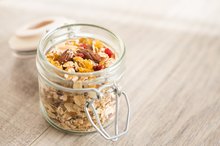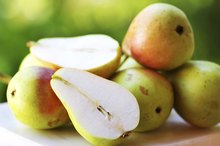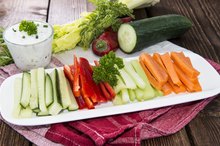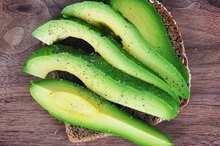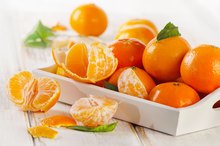What does fact checked mean?
At Healthfully, we strive to deliver objective content that is accurate and up-to-date. Our team periodically reviews articles in order to ensure content quality. The sources cited below consist of evidence from peer-reviewed journals, prominent medical organizations, academic associations, and government data.
- Office of Dietary Supplements: Dietary Supplement Fact Sheet: Iron
- "The American Journal of Clinical Nutrition"; Ascorbic Acid Prevents the Dose-Dependent Inhibitory Effects of Polyphenols and Phytates on Nonheme-Iron Absorption; D. Siegenberg, et al.; February 1991
- "The American Journal of Clinical Nutrition"; Ascorbic Acid Prevents the Dose-Dependent Inhibitory Effects of Polyphenols and Phytates on Nonheme-Iron Absorption; D. Siegenberg, et al.; February 1991
The information contained on this site is for informational purposes only, and should not be used as a substitute for the advice of a professional health care provider. Please check with the appropriate physician regarding health questions and concerns. Although we strive to deliver accurate and up-to-date information, no guarantee to that effect is made.
Apples & Iron
An apple may not have been the fruit Eve supposedly used to tempt Adam -- some Biblical scholars maintain that it was the pomegranate -- but apples still have plenty of credibility with nutritionists, doctors and natural healers, who recommend them for their many health benefits. High in dietary fiber, low in fat and rich in vitamins and minerals, apples are a healthy dietary choice. Iron, an essential mineral, is necessary for the transport of oxygen in the body. Although apples contain only modest levels, they promote the absorption of iron from other foods.
Basics and Benefits
A medium-sized apple contains .47 g of protein, .31 g of fat, 25.13 g of carbohydrates, 4.4 g of fiber and 18.91 g of sugars, mostly in the form of fructose. Apples are low-fat, low-salt and free of cholesterol; their reasonable count of 95 calories apiece makes them a bargain for dieters. Pectin, a soluble fiber in apples, can help lower harmful LDL cholesterol. By slowing the absorption of fructose in the body, pectin helps to stabilize blood-sugar levels; it also helps create a feeling of fullness that may help ward off overeating. In addition, apples are rich in the antioxidants quercetin and ellagic acid, which scavenge destructive free radicals in the body.
- A medium-sized apple contains .47 g of protein, .31 g of fat, 25.13 g of carbohydrates, 4.4 g of fiber and 18.91 g of sugars, mostly in the form of fructose.
- In addition, apples are rich in the antioxidants quercetin and ellagic acid, which scavenge destructive free radicals in the body.
Iron Features
Do Beans Have Iron?
Learn More
Iron, an essential mineral, is necessary for the production of hemoglobin, a protein that transports oxygen through the body; it is also required for the growth and differentiation of cells. Dietary iron is divided into two types, with heme iron -- found in hemoglobin -- occurring in animal foods such as meat, poultry and fish. Nonheme iron occurs in plant foods such as lentils and beans. Certain substances in foods -- such as tannic acids in teas and phytates in grains -- can interfere with the absorption of iron. The World Health Organization reports that 80 percent of the world's population is deficient in iron, with women of childbearing age most at risk. The recommended daily allowance of iron for adults is 8 mg for men and 18 mg for women. After age 50, requirements for women drop to 8 mg a day. Symptoms of iron deficiency include fatigue, weakness, difficulty maintaining body temperature and decreased immune system function.
- Iron, an essential mineral, is necessary for the production of hemoglobin, a protein that transports oxygen through the body; it is also required for the growth and differentiation of cells.
- Dietary iron is divided into two types, with heme iron -- found in hemoglobin -- occurring in animal foods such as meat, poultry and fish.
Iron in Apples
With a mere .22 mg of iron in a medium-sized apple, apples are not iron-rich. However, apples' vitamin C content can help to absorb iron from other foods eaten at the same meal. Although apples are not a good source of iron, they are rich in other minerals, including potassium. A medium apple contains 195 mg of this essential mineral, which regulates electrolytes -- or salts -- in the body to maintain normal heart rate and blood pressure. Copper is also present, in the amount of .049 mg per medium apple. Copper is a trace mineral needed by the body to produce hemoglobin, collagen, myelin and melanin.
- With a mere .22 mg of iron in a medium-sized apple, apples are not iron-rich.
Research
Can You Lose Weight Eating Cranberries & Almonds?
Learn More
Scientific research has demonstrated that the vitamin C in apples and other fruits promotes the use of iron in the body by overcoming substances that inhibit absorption. "The American Journal of Clinical Nutrition" reports a 1991 clinical study involving 199 volunteers in which researchers found that 30 mg of ascorbic acid -- or vitamin C -- overpowered the inhibitory effects of maize-bran phytates on non-heme iron absorption 4. Ascorbic acid also worked to overcome the inhibitory effects of tannins, and the authors advise 50 mg of vitamin C with a meal as the optimum dose for absorption.
- Scientific research has demonstrated that the vitamin C in apples and other fruits promotes the use of iron in the body by overcoming substances that inhibit absorption. "
Related Articles
References
- USDA National Nutrient Database
- Daily Mail; How An Apple a Day Can Keep Illness At Bay; Luci Hoe
- Office of Dietary Supplements: Dietary Supplement Fact Sheet: Iron
- "The American Journal of Clinical Nutrition"; Ascorbic Acid Prevents the Dose-Dependent Inhibitory Effects of Polyphenols and Phytates on Nonheme-Iron Absorption; D. Siegenberg, et al.; February 1991
- U.S. Department of Health and Human Services. National Institutes of Health. Iron Fact Sheet for Health Professionals. Office of Dietary Supplements. Published 2019.
- Sun J, Zhang L, Cui J et al. Effect of dietary intervention treatment on children with iron deficiency anemia in China: a meta-analysis. Lipids Health Dis. 2018;17(1). doi:10.1186/s12944-018-0749-x
- Beck KL, Conlon CA, Kruger R, Coad J. Dietary determinants of and possible solutions to iron deficiency for young women living in industrialized countries: a review. Nutrients. 2014;6(9):3747-76. doi:10.3390/nu6093747
- Hurrell R, Egli I. Iron bioavailability and dietary reference values. Am J Clin Nutr. 2010;91(5):1461S-1467S. doi:10.3945/ajcn.2010.28674F
- Institute of Medicine. 2001. Dietary Reference Intakes for Vitamin A, Vitamin K, Arsenic, Boron, Chromium, Copper, Iodine, Iron, Manganese, Molybdenum, Nickel, Silicon, Vanadium, and Zinc. Washington, DC: The National Academies Press. doi:10.17226/10026
- Zijp IM, Korver O, Tijburg LB. Effect of tea and other dietary factors on iron absorption. Crit Rev Food Sci Nutr. 2000;40(5):371-98. doi:10.1080/10408690091189194
- Centers for Disease Control and Prevention. Iron.
- Makrides, M., Hawkes, J. S., Neumann, M. A., & Gibson, R. A. (2002). Nutritional effect of including egg yolk in the weaning diet of breast-fed and formula-fed infants: a randomized controlled trial. The American Journal of Clinical Nutrition, 75(6), 1084–1092. doi:10.1093/ajcn/75.6.1084
- Itske M. Zijp, Onno Korver & Lilian B. M. Tijburg (2000) Effect of Tea and Other Dietary Factors on Iron Absorption, Critical Reviews in Food Science and Nutrition,40:5, 371-398, doi:10.1080/10408690091189194
- Lönnerdal, B. (2010). Calcium and Iron Absorption - Mechanisms and Public Health Relevance. International Journal for Vitamin and Nutrition Research, 80(45), 293–299. doi:10.1024/0300-9831/a000036
- Geerligs PD, Brabin BJ, Omari AA. Food prepared in iron cooking pots as an intervention for reducing iron deficiency anaemia in developing countries: a systematic review. J Hum Nutr Diet. 2003;16(4):275-81. doi:10.1046/j.1365-277X.2003.00447.x
- Abhilash KP, Arul JJ, Bala D. Fatal overdose of iron tablets in adults. Indian J Crit Care Med. 2013;17(5):311-3. doi:10.4103/0972-5229.120326
- Hamilton JPA, By, Hamilton JPA. Secondary Iron Overload - Blood Disorders. Merck Manuals Consumer Version.
- Iron - Infant and Toddler Nutrition. Centers for Disease Control and Prevention. Published 2018.
- Milk Free Diet For Iron Deficiency Anemia. Children's Hospitals and Clinics of Minnesota.
- Abhilash KP, Arul JJ, Bala D. Fatal overdose of iron tablets in adults. Indian J Crit Care Med. 2013;17(5):311–313. doi:10.4103/0972-5229.120326
- Beck KL, Conlon CA, Kruger R, Coad J. Dietary determinants of and possible solutions to iron deficiency for young women living in industrialized countries: a review. Nutrients. 2014;6(9):3747–3776. Published 2014 Sep 19. doi:10.3390/nu6093747
- de Benoist B, McLean E, Egil I, Cogswell M, eds. Worldwide Prevalence of Anaemia 1993-2005. World Health Organization, Centers for Disease Control and Prevention.
- Geerligs P, Brabin B, Omari A. Food prepared in iron cooking pots as an intervention for reducing iron deficiency anaemia in developing countries: a systematic review. Journal of Human Nutrition and Dietetics. 2003;16(4):275-281. doi:10.1046/j.1365-277x.2003.00447.x
- Hamilton, JPA. Secondary Iron Overload - Blood Disorders. Merck Manuals Consumer Version. February 2019.
- Hurrell R, Egli I. Iron bioavailability and dietary reference values. The American Journal of Clinical Nutrition. 2010;91(5). doi:10.3945/ajcn.2010.28674F
- Johnson-Wimbley T, Graham D. Diagnosis and management of iron deficiency anemia in the 21st century. Therap Adv Gastroenterol. 2011;4(3):177-184. doi:10.1177/1756283x11398736
- Verster A. Food fortification: good to have or need to have? Eastern Mediterranean Health Journal. 2004;10(6).
Writer Bio
Carol Sarao is an entertainment and lifestyle writer whose articles have appeared in Atlantic City Weekly, The Women's Newspaper of Princeton, and New Millennium Writings. She has interviewed and reviewed many national recording acts, among them Everclear, Live, and Alice Cooper, and received her Master of Fine Arts degree in writing from Warren Wilson College.

